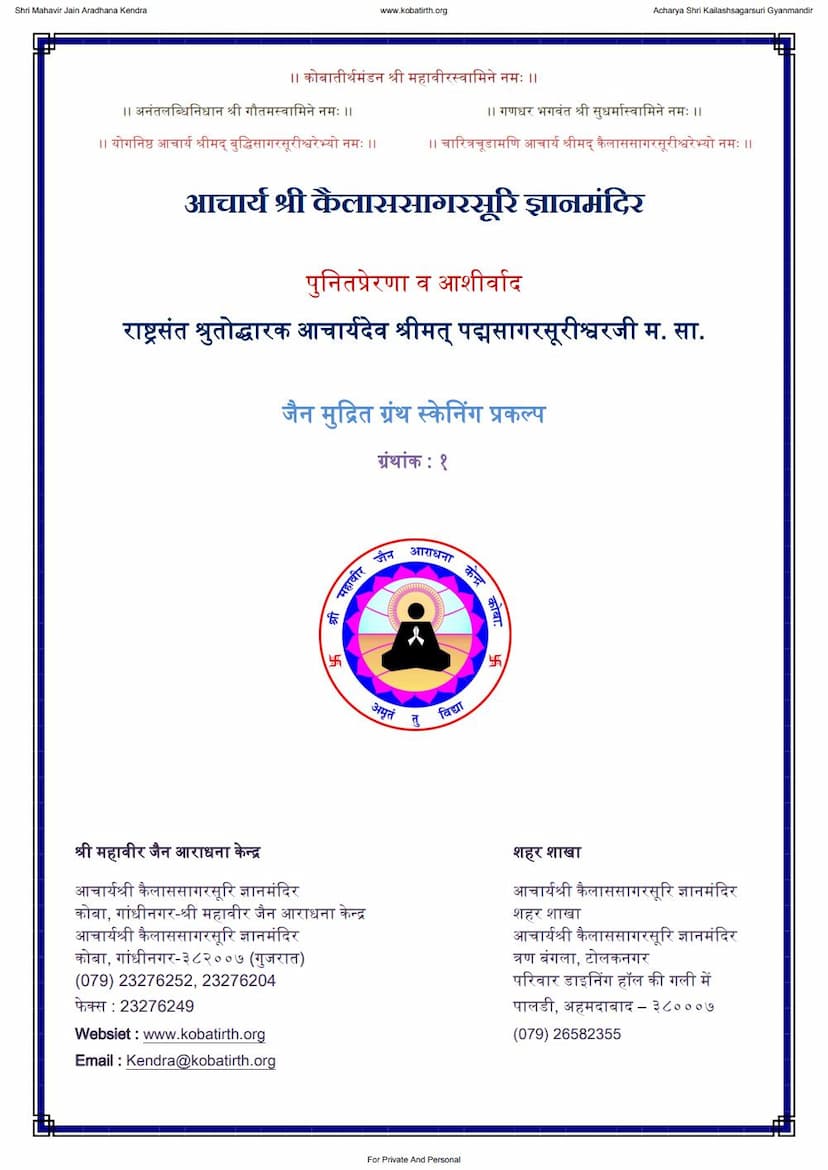Agam 14 Upang 03 Jivabhigam Sutra Shwetambar
Added to library: September 1, 2025

Summary
This document is the digital scan of the Jivabhigam Sutra, the third of the Upanga Agamas in the Shwetambara Jain canon, authored by Purnachandrasagar and published by Jainanand Pustakalay. It's part of a larger project to digitize Jain scriptures.
The scan includes introductory pages that:
- Express reverence: It begins with salutations to various revered Jain figures like Lord Mahavir, Gautam Swami, Sudharma Swami, and the lineage of Acharyas, highlighting their contributions to Jainism and the preservation of its scriptures.
- Detail the scanning project: It mentions the "Jain Mudrit Granth Scanning Project" and acknowledges the support and guidance from various Acharyas and scholars involved in the process.
- Trace the history of Agam recensions: A significant portion of the introduction (Pages 5-10) delves into the historical background and evolution of the Jain Agamas. It describes the six major recensions (Vachanas) of the Agamas, occurring over a period of about 1000 years after Lord Mahavir's Nirvana. These recensions were necessitated by various challenges, including:
- Famines and scattering of the Sangha: The first Vachana in Pataliputra was held due to a severe famine and the resulting disarray of the monastic community, leading to the compilation of the Twelve Angas.
- Need for preservation: Subsequent Vachanas were conducted to ensure the accurate preservation and transmission of the Agamic knowledge, often in response to political turmoil, the rise of different sects, and the gradual weakening of memory-based recitation due to adverse times.
- The role of great Acharyas: The text highlights the efforts of prominent Acharyas like Sthulabhadra, Aryarakshit, Skandila, Nagarjuna, Kalyansuri, and others in these compilations and preservations.
- The shift to written texts: It notes the tradition of oral recitation and the eventual move towards writing down the Agamas, particularly during the sixth Vachana in Valabhi, where the 84 Agamas were systematically compiled and inscribed on palm leaves.
- The later period of decline and revival: The introduction also touches upon the period of decline in the 10th century CE and the subsequent efforts in the 20th century, notably by Acharya Anandasagar Surishwarji Maharaj (also known as "Poo. Sagarji M."), who is credited with a significant revival and re-publication of the Agamas, making them accessible for communal study.
The Jivabhigam Sutra itself (starting from Page 11):
The scanned content then moves into the core of the Jivabhigam Sutra, presenting a detailed classification and description of living beings (Jivas) and non-living entities (Ajivas) according to Jain philosophy. The initial sections outline:
- The fundamental classification:
- Ajivabhigam (Classification of the Non-living): This is divided into Rupia Ajivabhigam (Corporeal non-living) and Arupia Ajivabhigam (Incorporeal non-living).
- Arupia Ajivabhigam is further detailed as comprising ten categories, starting with Dharma-stikaya and proceeding as in the Pannavana Sutra up to what constitutes Arupia Ajivabhigam.
- Rupia Ajivabhigam includes Khanda (aggregates), Khanda-desa (parts of aggregates), Khanda-pradesha (points of aggregates), and Paramanu-pudgala (fundamental particles). These are further elaborated in terms of their five types (color, smell, taste, touch, and form).
- Jivabhigam (Classification of the Living): This is divided into Sansara-samavannaga Jiva (Souls in the cycle of transmigration) and Asansara-samavannaga Jiva (Souls liberated from the cycle of transmigration).
- Asansara-samavannaga Jiva is further divided into Anantara-siddha (immediately liberated) and Parampara-siddha (gradually liberated), with Anantara-siddha being described as fifteen types.
- Sansara-samavannaga Jiva discusses various classifications of souls within the cycle of birth and death. The text details the enumeration of souls based on different perspectives (e.g., two, three, four, or up to ten types of souls in the cycle).
- Ajivabhigam (Classification of the Non-living): This is divided into Rupia Ajivabhigam (Corporeal non-living) and Arupia Ajivabhigam (Incorporeal non-living).
- Detailed descriptions of Jivas (Souls): The Sutra then proceeds to classify living beings extensively, focusing on their characteristics, which includes:
- Classification by senses: From one-sensed beings (Ekendriya) to five-sensed beings (Panchendriya).
- Types of Ekendriya: Further categorized into Prithvi-kaya (earth-bodied), Ap-kaya (water-bodied), Teu-kaya (fire-bodied), Vayu-kaya (air-bodied), and Vanaaspati-kaya (plant-bodied).
- Sub-classifications: Within each category, there are further distinctions, such as:
- Sukshma (subtle) and Badara (gross) beings: For example, Sukshma Prithvi-kaya and Badara Prithvi-kaya.
- Paryapta (fully developed) and Aparyapta (undeveloped) beings: Describing their states of development.
- Detailed characteristics: The text elaborates on various attributes of these beings, including their bodies (Sharira), lifespan (Sthiti), senses (Indriya), passions (Kasaya), mind (Sannin/Asannin), color-related properties (Varna), smell (Gandha), taste (Rasa), touch (Sparsha), shape (Samsthana), origin (Upavada), states of existence (Gati), and many other specific attributes.
- The cycle of existence: The text details the transmigration of souls, the duration of their existence in different realms (hellish beings, animals, humans, celestial beings), and the permutations and combinations thereof.
- Detailed classification of various life forms: The latter part of the scanned document delves into intricate classifications of various beings, including different types of hellish beings (Naraka), their locations and characteristics, various types of animals (living beings with one to five senses), including aquatic, terrestrial, and aerial creatures, humans (Karmabhumi, Akarmabhumi, Antardvipaka), and celestial beings (Devas) of different classes.
- Specific details on different life forms: The Jivabhigam Sutra systematically explores the characteristics of each life form, providing details on their:
- Lifespan and transmigration: How long they exist and the realms they move between.
- Physical and sensory attributes: Their bodies, senses, qualities, and even the subtle details of their existence.
- Geographical distribution: Where these beings reside within the various realms of the universe.
- Classification by gender and consciousness: Including distinctions between male, female, neuter beings, and conscious vs. unconscious states.
- The nature of hellish beings: A significant portion is dedicated to the realms of hell, their inhabitants, suffering, and the structures associated with them.
In essence, the Jivabhigam Sutra is a comprehensive cosmological and biological treatise from a Jain perspective, aiming to provide a complete understanding of all forms of life and their place in the universe, which is fundamental to understanding the Jain path of liberation through non-violence and right conduct.